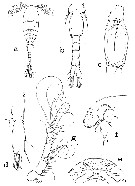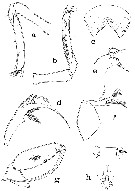|
|
 |
Fiche d'espèce de Copépode |
|
|
Cyclopoida ( Ordre ) |
|
|
|
Lubbockiidae ( Famille ) |
|
|
|
Laitmatobius ( Genre ) |
|
|
| |
Laitmatobius crinitus Humes, 1987 (M) | |
| | | | | | | Ref.: | | | Humes, 1987 (p.663, figs.M ); Huys & Böttger-Schnack, 1996/97 (p.257); Boxshall & Halsey, 2004 (p.577, fig.M) |  Issued from : A.G. Humes in Bull. mar. Sc., 1987, 41 (3). [p.664, Fig.9]. Male (from 27°00'N, 111°30'W): a, habitus (dorsal); b, urosome (dorsal); c, segment bearing P5 and genital segment (lateral); d, caudal ramus (dorsal); e, rostrum (ventral view); f, same (lateral view); g, A1 (ventro-inner). Nota: Pedigerous somite of P1 longer than following pedigerous segments, distinctly separated from cephalosome. - Epimeral areas of metasomal segments not prominent. - Segments of P2-P4 dorsally with longitudinal and obique sclerotized bars. - Ratio of length to width of prosome 2.3 : 1. - Ratio of length of prosome to that of urosome 1.45 : 1. - Genital segment elongate. - Four postgenital segments. - Caudal ramus elongate; ratio 2.71 : 1. Outer lateral seta and smooth, outermost terminal seta smooth; dorsal seta, innermost terminal seta, and 2 median terminal setae, long, all curled and with delicate lateral hairs. - Body surface withe sensilla and refractile points (as fig.9a, b). - Rostrum shallowy rounded in ventral view butt forming blunt lobe in lateral view; surface with conspicuous refractile areas. - A1 5-segmented. 5th segment showing partial crease but still entire segment. Length of segments 26 (55µm along anterior margin), 62, 10, 78 and 86 µm respectively. Formula armature: 4, 13, 4, 4, 11 +1 aesthete, all setae smooth; segments 2, 4 and 5 with certain setae very long and curled
|
 Issued from : A.G. Humes in Bull. mar. Sc., 1987, 41 (3). [p.666, Fig.10]. Male: a, A2 (anterior); b, same (posterior; c, labrum (ventral); d, Md (posterior); e, Mx1 (anterior); f, Mx2 (postero-outer); g, Mxp (antero-inner); h, area between Mxp and P1 (ventral). Nota: A2 4-segmented with 4 small terminal claws. 1st segment unusually long and slender. Formula1, 1, 3, and 2 + IV. Seta on 1st segment very small. All setae naked. 3rd and 4th segments with spinules on posterior surface. - Labrum with 2 posteroventral lobes bluntly pointed, surface bearing refractile points. - Md elongate, basal portion bearing 2 spinulose outer spines and 1 inner seta plumose both laterally and superficially; distal portion forming long lash with its proximal outer area expanded and serrate. - Paragnath not seen. - Mx1 bilobed, smaller lobe bearing 3 nearly equal setae and row of minute spinules, larger lobe with 2 unequal setae. All setae minutely barbed. - Mx2 2-segmented. 1st segment expanded and unarmed; 2nd segment, small slender, bearing 1 naked subterminal seta and 2 terminal spines both with long spinules. - Mxp 4-segmented (assuming proximal part of claw to represent 4th segment). 1st segment short, broad with row of small spinules distally; 2nd segment elongate with 2 patches of spinules and 2 small unequal setae, 2 sensilla on postero-outer surface; 3rd segment small and unarmed, with sclerotization suggesting division of segment. Claw slender and long, with 1 small inner seta near base.
|
 Issued from : A.G. Humes in Bull. mar. Sc., 1987, 41 (3). [p.667, Fig.11]. Male: a, P1 and intercoxal plate (anteror); b, P2 (posterior); c, endopod of P3 (anterior); d, P4 (anterior); e, P5 (dorsal); f, genital segment with P6 (ventral). Nota: P5 with small unornamented free segment 21 x 8 mm. Two unequal terminal setae 57 µm (outer) and smooth, and 1212 µm (inner) with few delicate hairs. Adjacent dorsal seta 42 µm.
|
 Issued from : A.G. Humes inBull. mar. Sc., 1987, 41 (3). [p.665]. Male: Setal formula of swimming legs P1 to P4.
|
 Issued from : G.A. Boxshall & S.H. Halsey in The Ray Soc., 2004, No 166, Part II. [p.576, Fig.186, E]. Male: E, A2. :Generic and species diagnosis: 1 - P1 and P2 with outer spines on 3rd exopodal segment. 2 - Antennary endopod 3-segmented. (coxa and basis forming unarmed coxobasis, 1st endopodal segment with 1 seta; 2nd and 3rd segments free)
| | | | | NZ: | 1 | | |
|
Carte de distribution de Laitmatobius crinitus par zones géographiques
|
| | | | Loc: | | | G. of California (Guaymas Basin)
Type locality: 27°00' N, 111°30' W. | | | | N: | 1 | | | | Lg.: | | | (935) M: 1,29-1,38; {M: 1,29-1,38} | | | | Rem.: | Deep-sea vents (2000 m)
Voir aussi les remarques en anglais | | | Dernière mise à jour : 12/10/2015 | |
|
|
 Toute utilisation de ce site pour une publication sera mentionnée avec la référence suivante : Toute utilisation de ce site pour une publication sera mentionnée avec la référence suivante :
Razouls C., Desreumaux N., Kouwenberg J. et de Bovée F., 2005-2025. - Biodiversité des Copépodes planctoniques marins (morphologie, répartition géographique et données biologiques). Sorbonne Université, CNRS. Disponible sur http://copepodes.obs-banyuls.fr [Accédé le 23 août 2025] © copyright 2005-2025 Sorbonne Université, CNRS
|
|
 |
 |







